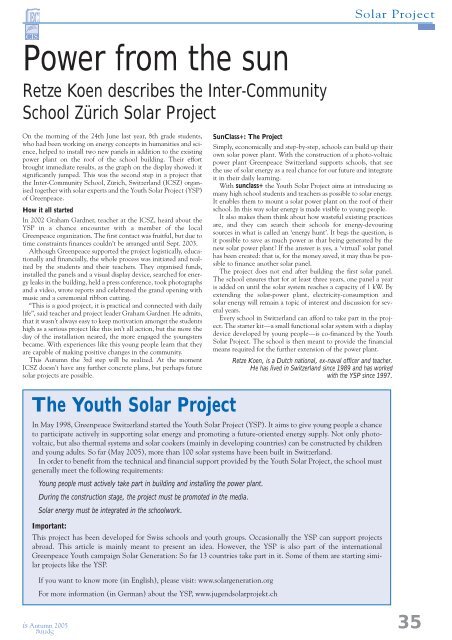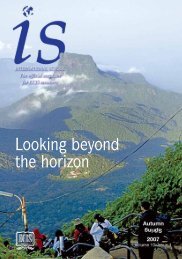is magazine 8.1 - Autumn/Spring 2005 - International Schools ...
is magazine 8.1 - Autumn/Spring 2005 - International Schools ...
is magazine 8.1 - Autumn/Spring 2005 - International Schools ...
You also want an ePaper? Increase the reach of your titles
YUMPU automatically turns print PDFs into web optimized ePapers that Google loves.
Power from the sun<br />
Retze Koen describes the Inter-Community<br />
School Zürich Solar Project<br />
On the morning of the 24th June last year, 8th grade students,<br />
who had been working on energy concepts in humanities and science,<br />
helped to install two new panels in addition to the ex<strong>is</strong>ting<br />
power plant on the roof of the school building. Their effort<br />
brought immediate results, as the graph on the d<strong>is</strong>play showed: it<br />
significantly jumped. Th<strong>is</strong> was the second step in a project that<br />
the Inter-Community School, Zürich, Switzerland (ICSZ) organ<strong>is</strong>ed<br />
together with solar experts and the Youth Solar Project (YSP)<br />
of Greenpeace.<br />
How it all started<br />
In 2002 Graham Gardner, teacher at the ICSZ, heard about the<br />
YSP in a chance encounter with a member of the local<br />
Greenpeace organization. The first contact was fruitful, but due to<br />
time constraints finances couldn’t be arranged until Sept. 2003.<br />
Although Greenpeace supported the project log<strong>is</strong>tically, educationally<br />
and financially, the whole process was initiated and realized<br />
by the students and their teachers. They organ<strong>is</strong>ed funds,<br />
installed the panels and a v<strong>is</strong>ual d<strong>is</strong>play device, searched for energy<br />
leaks in the building, held a press conference, took photographs<br />
and a video, wrote reports and celebrated the grand opening with<br />
music and a ceremonial ribbon cutting.<br />
“Th<strong>is</strong> <strong>is</strong> a good project, it <strong>is</strong> practical and connected with daily<br />
life”, said teacher and project leader Graham Gardner. He admits,<br />
that it wasn’t always easy to keep motivation amongst the students<br />
high as a serious project like th<strong>is</strong> <strong>is</strong>n’t all action, but the more the<br />
day of the installation neared, the more engaged the youngsters<br />
became. With experiences like th<strong>is</strong> young people learn that they<br />
are capable of making positive changes in the community.<br />
Th<strong>is</strong> <strong>Autumn</strong> the 3rd step will be realized. At the moment<br />
ICSZ doesn’t have any further concrete plans, but perhaps future<br />
solar projects are possible.<br />
The Youth Solar Project<br />
<strong>is</strong> <strong>Autumn</strong> <strong>2005</strong><br />
<strong>Spring</strong><br />
SunClass+: The Project<br />
Simply, economically and step-by-step, schools can build up their<br />
own solar power plant. With the construction of a photo-voltaic<br />
power plant Greenpeace Switzerland supports schools, that see<br />
the use of solar energy as a real chance for our future and integrate<br />
it in their daily learning.<br />
With sunclass+ the Youth Solar Project aims at introducing as<br />
many high school students and teachers as possible to solar energy.<br />
It enables them to mount a solar power plant on the roof of their<br />
school. In th<strong>is</strong> way solar energy <strong>is</strong> made v<strong>is</strong>ible to young people.<br />
It also makes them think about how wasteful ex<strong>is</strong>ting practices<br />
are, and they can search their schools for energy-devouring<br />
sources in what <strong>is</strong> called an ‘energy hunt’. It begs the question, <strong>is</strong><br />
it possible to save as much power as that being generated by the<br />
new solar power plant? If the answer <strong>is</strong> yes, a ‘virtual’ solar panel<br />
has been created: that <strong>is</strong>, for the money saved, it may thus be possible<br />
to finance another solar panel.<br />
The project does not end after building the first solar panel.<br />
The school ensures that for at least three years, one panel a year<br />
<strong>is</strong> added on until the solar system reaches a capacity of 1 kW. By<br />
extending the solar-power plant, electricity-consumption and<br />
solar energy will remain a topic of interest and d<strong>is</strong>cussion for several<br />
years.<br />
Every school in Switzerland can afford to take part in the project.<br />
The starter kit—a small functional solar system with a d<strong>is</strong>play<br />
device developed by young people—<strong>is</strong> co-financed by the Youth<br />
Solar Project. The school <strong>is</strong> then meant to provide the financial<br />
means required for the further extension of the power plant.<br />
Retze Koen, <strong>is</strong> a Dutch national, ex-naval officer and teacher.<br />
He has lived in Switzerland since 1989 and has worked<br />
with the YSP since 1997.<br />
In May 1998, Greenpeace Switzerland started the Youth Solar Project (YSP). It aims to give young people a chance<br />
to participate actively in supporting solar energy and promoting a future-oriented energy supply. Not only photovoltaic,<br />
but also thermal systems and solar cookers (mainly in developing countries) can be constructed by children<br />
and young adults. So far (May <strong>2005</strong>), more than 100 solar systems have been built in Switzerland.<br />
In order to benefit from the technical and financial support provided by the Youth Solar Project, the school must<br />
generally meet the following requirements:<br />
Young people must actively take part in building and installing the power plant.<br />
During the construction stage, the project must be promoted in the media.<br />
Solar energy must be integrated in the schoolwork.<br />
Important:<br />
Th<strong>is</strong> project has been developed for Sw<strong>is</strong>s schools and youth groups. Occasionally the YSP can support projects<br />
abroad. Th<strong>is</strong> article <strong>is</strong> mainly meant to present an idea. However, the YSP <strong>is</strong> also part of the international<br />
Greenpeace Youth campaign Solar Generation: So far 13 countries take part in it. Some of them are starting similar<br />
projects like the YSP.<br />
If you want to know more (in Engl<strong>is</strong>h), please v<strong>is</strong>it: www.solargeneration.org<br />
For more information (in German) about the YSP, www.jugendsolarprojekt.ch<br />
Solar Project<br />
35




